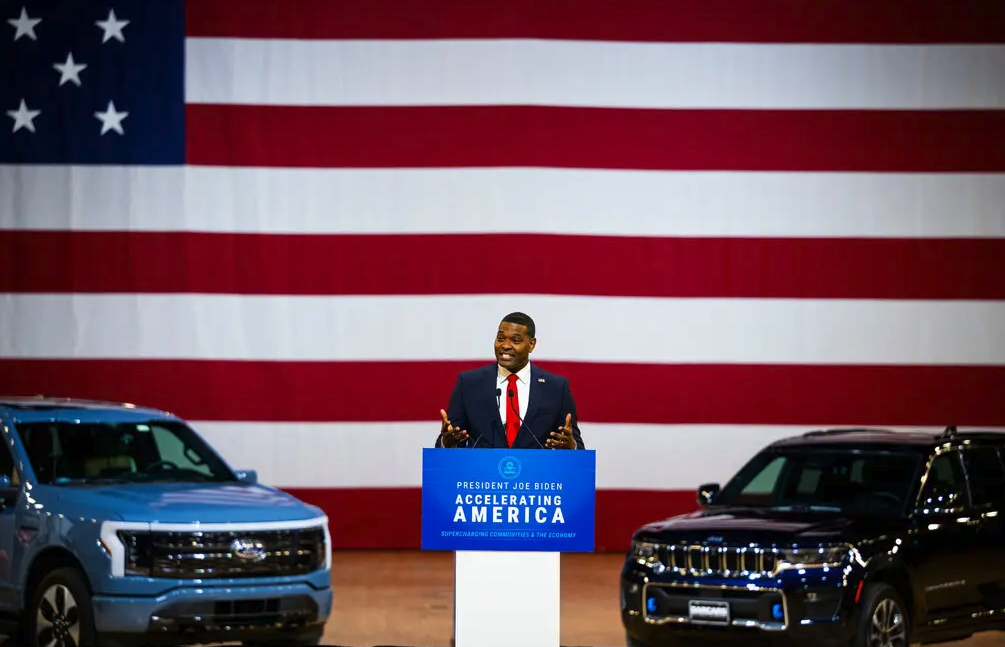By Glynn Wilson –
WASHINGTON, D.C. — The stakes could not be higher for the future of the United States and humanity. There is a consensus based on an overwhelming amount of scientific evidence that continuing to burn fossil fuels for energy and transportation will doom the next generation of humans to living through a hellscape on Earth from climate change due to the effects global warming, and face economic uncertainty and grave national security risks too.
Responding to this consensus, the Biden administration issued one of the most significant regulations ever proposed to combat climate change on Wednesday, a rule designed to make sure that the majority of new passenger cars and light trucks sold in the United States are all-electric or hybrids by 2032.
The final national pollution standards for passenger cars, light-duty trucks and medium-duty vehicles for model years 2027 through 2032 will prevent more than 7 billion tons of carbon emissions from being spewed into the atmosphere and provide nearly $100 billion of annual net benefits to society, according to the announcement, including $13 billion of annual public health benefits due to improved air quality, plus $62 billion in reduced annual fuel costs and maintenance and repair costs for drivers.
“Three years ago, I set an ambitious target: that half of all new cars and trucks sold in 2030 would be zero-emission,” President Biden in a statement in announcing the plan. “Together, we’ve made historic progress. Hundreds of new expanded factories across the country. Hundreds of billions in private investment and thousands of good-paying union jobs. And we’ll meet my goal for 2030 and race forward in the years ahead.”
That is unless his opponent somehow avoids prison and bankruptcy and manages to convince enough voters to return him to the White House. Even with a consensus in the scientific community, there are still industries and politicians trying to make this a divisive wedge issue in the 2024 presidential campaign.
Presumptive Republican nominee Donald Trump has vowed to gut the federal regulations if he is returned to power in November. He has been accused of trying to “weaponize” electric vehicles, repeating false claims during campaign rallies about their performance and affordability and using increasingly heated rhetoric. Most recently, in the middle of remarks about electric vehicles, Trump warned of a “blood bath” in America if President Biden is reelected.
Cars and other forms of transportation are, together, the largest single source of carbon emissions generated in the U.S., pollution that is driving climate change and that helped to make 2023 the hottest year in recorded history. Electric vehicles are central to President Biden’s strategy to confront global warming, which calls for cutting the nation’s emissions in half by the end of this decade.
But the American Fuel and Petrochemical Manufacturers, an industry lobbying outfit, has started what it says is a “seven figure” campaign of advertising, phone calls and text messages against what it FALSELY calls “Biden’s E.P.A. car ban” in swing states such as Pennsylvania, Michigan, Wisconsin, Nevada and Arizona, as well as Ohio, Montana and Washington.
The federal regulation is not a ban. It does not mandate the sales of electric vehicles. Gas-powered cars and trucks will still be sold for years to come. It simply requires automakers to meet tough new average emissions limits across their entire product line. It’s up to the manufacturers to decide how to comply.
Under the Clean Air Act, the agency can limit the pollution generated by the total number of cars sold each year. EPA officials said automakers could comply with the emissions caps by selling a mix of conventional gas-burning cars, hybrids, electric vehicles or other types of vehicles, such as cars powered by hydrogen. The new regulation, which would not apply to sales of used automobiles or light trucks, would take effect starting with model year 2027. Auto companies that exceed the new restrictions could face substantial penalties.
The EPA projects an increase in U.S. auto manufacturing employment in response to the final standards, consistent with the broader Biden-Harris administration commitment to creating good-paying, union jobs by leading the clean vehicle future. Strong standards have historically contributed to the U.S. leading the world in the supply of clean technologies, the administration says, with corresponding benefits for American global competitiveness and domestic employment.
Since President Biden took office, companies have announced more than $160 billion in investment in U.S. clean vehicle manufacturing and the U.S. auto manufacturing sector has added more than 100,000 jobs. A record 1.2 million electric vehicles rolled off dealers’ lots last year, but they made up just 7.6 percent of total U.S. car sales, far from the 56 percent target under the new regulation. An additional 16 percent of new cars sold would be hybrids.
In making the case to the public for the need of new standards, the EPA says the plan will provide greater certainty for the auto industry, catalyze private investment, and invigorate and strengthen the U.S. auto industry. Over the next decade, the standards, along with President Biden’s historic Investing in America agenda and investments in U.S. manufacturing, will set the U.S. auto sector on a trajectory for sustained growth into the foreseeable future.
The administration is also emphasizing how the final standards will lower costs for consumers. Once fully phased in, the standards are estimated to save the average American driver an estimated $6,000 in reduced fuel and maintenance over the life of a vehicle.
EPA Administrator Michael S. Regan joined President Biden’s National Climate Advisor Ali Zaidi in making the announcement in Washington.
“With transportation as the largest source of U.S. climate emissions, these strongest-ever pollution standards for cars solidify America’s leadership in building a clean transportation future and creating good-paying American jobs, all while advancing President Biden’s historic climate agenda,” said EPA Administrator Michael S. Regan. “The standards will slash over 7 billion tons of climate pollution, improve air quality in overburdened communities, and give drivers more clean vehicle choices while saving them money. Under President Biden’s leadership, this Administration is pairing strong standards with historic investments to revitalize domestic manufacturing, strengthen domestic supply chains and create good-paying jobs.”
The final standards build on EPA’s existing emissions standards for passenger cars and light trucks for model years 2023 through 2026. The standards continue the technology-neutral and performance-based design of previous EPA standards for cars, pickups, and vans, and leverage advances in clean car technologies to further reduce both climate pollution and smog- and soot-forming emissions. The EPA is finalizing the same standard proposed for 2032 while allowing additional time for the auto sector to scale up clean vehicle manufacturing supply chains in the first three years covered by the rule.
“President Biden is investing in America, in our workers, and in the unions that built our middle class and established the U.S. auto sector as a leader in the world,” Zaidi added.
“The President’s agenda is working,” he said. “On factory floors across the nation, our autoworkers are making cars and trucks that give American drivers a choice – a way to get from point A to point B without having to fuel up at a gas station. From plug-in hybrids to fuel cells to fully electric, drivers have more choices today. Since 2021, sales of these vehicles have quadrupled and prices continue to come down. This growth means jobs, and it means we are moving faster and faster to take on the climate crisis – all thanks to the President’s leadership.”
The net benefits to society are estimated to be $99 billion annually. The final rule is expected to avoid 7.2 billion tons of CO2 emissions through 2055, roughly equal to four times the emissions of the entire transportation sector in 2021. It will also reduce fine particulate matter and ozone, preventing up to 2,500 premature deaths between now and 2055 as well as reducing heart attacks, respiratory and cardiovascular illnesses, aggravated asthma and decreased lung function.
The administration relaxed some elements in the plan in concessions to auto manufacturers and their biggest union, the United Auto Workers. Even though major auto companies have been investing substantially in building and marketing all-electric vehicles, they have complained that the pace of change required under the rule as originally proposed a year ago was too rapid. Unionized auto workers fear a rapid transition to electric vehicles because they have fewer parts that require fewer workers to produce, and because many new EV plants are being built in states that don’t support union labor. Yet the union leadership is supporting the new plan.
“The EPA has made significant progress on its final greenhouse gas emissions rule for light-duty vehicles,” the United Automobile Workers said in a statement supporting the rule. “By taking seriously the concerns of workers and communities, the EPA has come a long way to create a more feasible emissions rule that protects workers building ICE vehicles, while providing a path forward for automakers to implement the full range of automotive technologies to reduce emissions.”
The regulations are expected to face legal challenges by a coalition of fossil fuel companies and Republican attorneys general, complaints that are likely to wind their way to the Supreme Court.
“They may wish for us all to drive E.V.s or no cars at all, but at the end of the day that’s not their decision,” said Elizabeth Murrill, the attorney general of Louisiana, a major oil and gas producing state that has been involved in a series of lawsuits challenging the Biden EPA “There is a limit to their authority to remake society in their own vision and the court has realized that.”
EPA received extensive feedback on the proposed rule, including written comments, testimony at public hearings and other stakeholder engagements. The final standards were informed by the best available data in the public record and rigorous technical assessments. EPA’s final rule gives manufacturers the flexibility to efficiently reduce emissions and meet the performance-based standards through the mix of technologies they decide is best for them and their customers.
Yet the rule is not without critics in the environmental community. A compromise in the final plan lowers the number of EVs that automakers must sell before 2030, meaning emissions would go down more slowly. Climate scientists have warned that emissions must drop sharply and quickly in order to combat the most catastrophic impacts of climate change.
“EPA caved to pressure from Big Auto, Big Oil and car dealers and riddled the plan with loopholes big enough to drive a Ford F150 through,” said Dan Becker, director of the Center for Biological Diversity’s Safe Climate Transport Campaign. Gas-powered cars would “dominate sales through much of this decade, guzzling and polluting into the middle of the century,” he said.
EPA officials countered that the final rule would still cut the same amount of emissions over 30 years.
Asked about that trade-off in a telephone call with reporters, Regan said the changes were designed to lead to a “stronger, more durable” policy, in other words, one less likely to be rolled back by a future administration or the courts. “We’re not sacrificing the environmental gains we want to see,” he said.
The EPA’s analysis considers a broad suite of available emission control technologies, and projects that consumers will continue to have a wide range of vehicle choices under the final rule, including advanced gasoline vehicles, hybrids, plug-in hybrid electric vehicles and full battery electric vehicles.
Compared to the existing 2026 standards, the final 2032 standards represent a nearly 50 percent reduction in projected fleet average emissions levels for light-duty vehicles and 44 percent in reductions for medium-duty vehicles. The standards are expected to reduce emissions of health-harming fine particulate matter from gasoline-powered vehicles by more than 95 percent. This will improve air quality nationwide and especially for people who live near major roadways and have environmental justice concerns.
The final rule reflects the significant investments in clean vehicle technologies that industry is already making domestically and abroad, as well as ongoing U.S. market shifts and increasing consumer interest in clean vehicles.
The Biden-Harris administration is also directly supporting communities across America in moving towards a cleaner transportation future by building a national network of EV chargers and alternative-fuel stations, as well as moving to help domestic manufacturers obtain the critical minerals and materials they need to make EV batteries and funding clean transit and clean school buses, with priority for underserved communities.
Public Reaction
“These standards form what we see as a historic climate grand slam for the Biden administration,” said Manish Bapna, president of the Natural Resources Defense Council Action Fund, a political action committee that aims to advance environmental causes. The group has calculated that the four regulations, combined with the Inflation Reduction Act, would reduce the nation’s greenhouse emissions 42 percent by 2030, getting the country most of the way to Biden’s 2030 target.
“I’ve always said Michigan automakers are the best in the world. And this is their moment,” said Senator Debbie Stabenow (MI). “I appreciate EPA’s commitment to engaging with our automakers and autoworkers to develop an ambitious but achievable final rule. It represents an opportunity for union workers to continue to build the vehicles of the future right here in the U.S. and tackle the climate crisis.”
“My priority will always be to protect American jobs and our environment, keep the United States at the forefront of automotive manufacturing, technology, and innovation, and keep our domestic industry strong and competitive,” said Congresswoman Debbie Dingell (MI-06). “The EPA has worked with all stakeholders to reach this final rule that includes hybrid and electric vehicles, and ensure these goals are achievable. It’s important to protect vehicle choice – the number of available models has doubled in the last three years, and in the last year sticker prices are down 20%. We need to continue to work on making sure that these vehicles are affordable to everyone, that we have the infrastructure in place to make them accessible and practical for consumers, and bring jobs back to the U.S. The bottom line is that the future of the industry must be created in America and driven by American workers, and we are all committed to working together toward that future.”
“The future is electric. Automakers are committed to the EV transition – investing enormous amounts of capital and building cutting edge battery electric vehicles, plug-in hybrids, traditional hybrids and fuel cell vehicles that drive efficiency and convert petroleum miles to electric miles,” said John Bozzella, President and CEO, Alliance for Automotive Innovation. “Consumers have tons of choices. But pace matters. Moderating the pace of EV adoption in 2027, 2028, 2029 and 2030 was the right call because it prioritizes more reasonable electrification targets in the next few (very critical) years of the EV transition. These adjusted EV targets – still a stretch goal – should give the market and supply chains a chance to catch up. It buys some time for more public charging to come online, and the industrial incentives and policies of the Inflation Reduction Act to do their thing. And the big one? The rules are mindful of the importance of choice to drivers and preserves their ability to choose the vehicle that’s right for them.”
“This is a day to celebrate American achievement. The step EPA is taking today will slash climate pollution and air pollution,” said Amanda Leland, Executive Director of Environmental Defense Fund. “It will bring more jobs for workers, more choices and more savings for consumers, and a healthier future for our children. The U.S. has leapt forward in the global race to invest in clean vehicles, with $188 billion and nearly 200,000 jobs on the way. Jobs in communities across the country, in places like Michigan, Nevada, and Kentucky. These clean car standards will help supercharge economic expansion and make America stronger.”
“These standards make clear that securing America’s global leadership in manufacturing and securing a better future are 100% aligned,” said Albert Gore, Executive Director of the Zero Emission Transportation Association. “We have everything we need today to meet and exceed this standard, and that means more of the vehicles sold in America will be made in America.”
See more information about the final rule online.
If you support truth in reporting with no paywall, and fearless writing with no popup ads or sponsored content, consider making a contribution today with GoFundMe or Patreon or PayPal.














